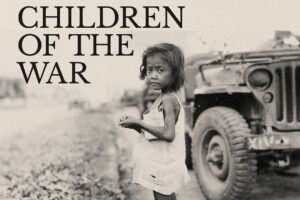CHILDREN of the War is a documentary film about survivors of the Battle of Manila, now in their 80s and 90s, as they recount the harrowing experiences they lived through as children and teenagers who witnessed the most brutal urban battle of the Pacific War.
Produced by Memorare Manila 1945, a foundation that aims to honor the 100,000 innocent non-combatant civilians who were killed in the Battle of Manila, the film was made in time for the 80th anniversary of the tragic event.
Its director, Mike Alcazaren, previously did 11,103, a documentary about survivors of Martial Law. With Children of the War, his purpose of filming shifted — from battling historical revisionism to capturing the last, firsthand memories of a war from eight decades ago.
“It started out as a short film, with the goal to get survivors on camera, since they are already getting old and dying,” Mr. Alcazaren told BusinessWorld in a voice call.
He explained that, in the process of looking for funding, they decided to expand it into a feature-length documentary. They started filming in May last year, while the foundation was still raising funds.
“The challenge was getting firsthand accounts. Memorare had a few leads, but most of them had passed on last year. After a lot of cold messages and calls, it was by chance that we found some,” he said.
FOR YOUNGER GENERATIONSFely Zafra-Reyes was the first source they got. A 96-year-old woman living in Padre Faura, Manila, the shoot was attended by family members who referred them to even more leads.
Some of their stories are horrific — witnessing parents, siblings, relatives, and friends mercilessly gunned down; women molested and murdered; men stabbed by bayonets or beheaded by swords.
However, it is important that these accounts are properly documented for future generations, Mr. Alcazaren said.
“I wanted their perspectives as children at the time, to make it real for younger generations. How do we make it more real for them? It has to be a firsthand account of what it feels like to be there,” he explained.
But even before approaching the subject matter as a documentary filmmaker, his interest in the Battle of Manila was piqued in the early 2010s, when his son was in grade school and their class needed a resource speaker to talk about World War II.
“My late father was a survivor of the Singalong district, where there were shellings and massacres,” said Mr. Alcazaren. “It was around 2012 and he was talking to grade schoolers about the houses they evacuated, the bloodshed, the escape. Interestingly, these kids were riveted, and the teachers were crying.”
Aside from having a strong educational curriculum that includes historical events like Martial Law and the Battle of Manila, the younger generations are best reached through pop culture, he said.
TV series like Pulang Araw on Netflix, and short-form online content on Facebook, YouTube, and TikTok made by the likes of The Filipino Story and history professor Xiao Chua are some examples.
“We just need to get the discussion going by putting out stories in formats that younger people will watch,” Mr. Alcazaren said.
WHAT’S NEXTChildren of the War will premiere on Feb. 23, 4 p.m., at the Metropolitan Theater in Manila, but its journey will not end there. Memorare Manila 1945 aims for the commissioned material to be used in curricula in schools and universities.
Mr. Alcazaren will also rework the documentary into a festival version, with the help of a grant from the Film Development Council of the Philippines.
“We’ll apply for more funding because it’s difficult to get more archival footage and make dioramas for reenactments. Part of the budget is also to get licenses for photos,” he explained.
While photos in the US National Archives are free for use as they are in the public domain, they are of low quality and it requires a fee to access the high-definition versions. There are also many powerful pictures from the Associated Press and the Library of Carl Mydans, an American photographer who covered the Battle of Manila.
Mr. Alcazaren told BusinessWorld that improving the documentary and going a festival route will reach a wider global audience.
“Documentaries do well in festivals. There are several documentary festivals, too, and we want to do that to get more attention to the story,” he said.
The Battle of Manila was the only battle in the Pacific theater of war that involved house-to-house combat, which is the worst kind to conduct. It is facts like these, according to the director, that are not well-known within the Philippines, and even less so in other countries.
He said that it should place a burden on Filipinos to give importance to Manila as a historic city. “It’s real proof of how Manila was never restored to its real glory pre-war,” he said. — Brontë H. Lacsamana






